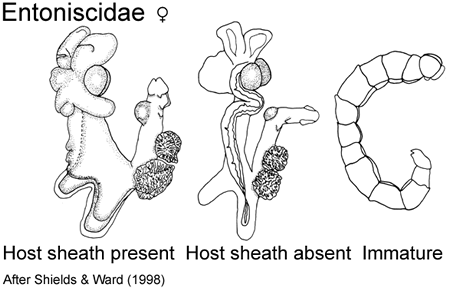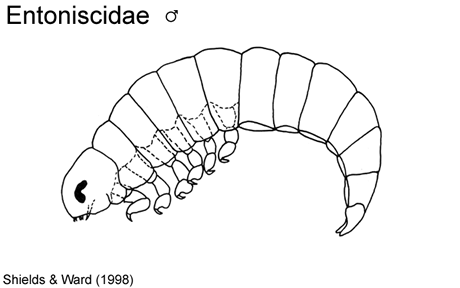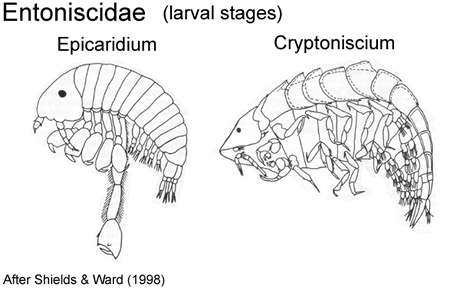 |
||||||
|
|
|
|
|
|
Australian Isopoda: FamiliesS.J. Keable, G.C.B. Poore & G.D.F. WilsonEntoniscidae Müller, 1871 Entoniscidae Müller, 1871: page not known. -Trilles, 1999: 344. Description. Body. Body shape asymmetrical with loss, or gross modification, of appendages on one side of the body, or without loss or gross modification of appendages on one side of the body; in dorsal view without peduncular articles of antenna 1 or 2 contiguous with coxal margins. Exoskeleton at least partly rigid, or not rigid. Head. Head not capable of lateral rotation (laterally encompassed, abutting or fused to pereonite 1). Antenna 1 inserting on head anteriorly and/or dorsally to antenna 2, minute or well developed; not as follows: reduced to 2 articles with second article expanded and scalloped. Antenna 2 vestigial, or well developed; of 5-7 articles. Mouthparts reduced, forming a suctorial cone containing mandibles which are modified as a pair of piercing stylets, or lost, replaced by small proboscis, or not forming suctorial cone or proboscis. Mandible not projecting anteriorly and together forceps-like; palp absent. Pereon. Pereonites 6-7 pereonite 7 distinct dorsally, free. Coxae extending ventrally and laterally to overhang the coxa-basis articulation of the pereopods. Pereopods 6-7 pairs readily apparent; 1-7 prehensile, propodus swollen on at least some. Pereopods 5-7 without flattened setose articles andor dactyls modified or absent. Pereopod 6 differentiated from pereopods 1-5. Pleon / Pleotelson. Pleopods uniramous, or biramous (the key of Trilles (1999) suggests that epicaridean larvae of Entoniscidae have uniramous pleopods, however, Shields & Ward (1998) describe the pleopods of the epicaridean stage of Tiarinion texopallium as biramous); 5 pairs present. Pleopod 2 of males not consisting of an enlarged peduncle with a geniculate endopod and a small muscular exopod. Pleotelson well developed. Uropods positioned proximally on pleotelson; distinct from pleopods, not forming operculum over pleopodal chamber (although may be folded ventrally below pleotelson). Peduncle not forming an elongate clavate article with rami reduced or absent. Endopod not claw-like (acute and recurved) andor posteroventral in position. Exopod not folded dorsally over pleotelson. Remarks. The key of Trilles (1999) suggests that epicaridean larvae of Entoniscidae have uniramous pleopods, however, Shields & Ward (1998) describe the pleopods of the epicaridean stage of Tiarinion texopallium as biramous. Dreyer & Wägele (2001) have proposed reclassifying the suborder Epicaridea as a family with previously recognised families becoming a subfamilies within this. Their proposal has not been implemented by Martin & Davis (2001) and is not followed here. Trilles (1999) and Martin & Davis (2001) attribute the family name to Kossmann (1881) but Kensley et al. (1996) attribute it to Müller (1871). Distribution and generic composition. See Kensley et al. (1996).
Cite this publication as: 'S.J. Keable, G.C.B. Poore & G.D.F. Wilson (2002 onwards). 'Australian Isopoda: Families. Version: 2 October 2002. https://crustacea.net'. |
|
|
|
|
|
|
|
|
|
Copyright © Australian Museum, 2002 - 2003
Australian Museum website


